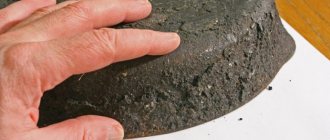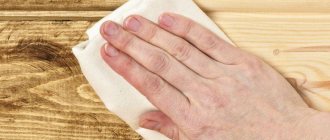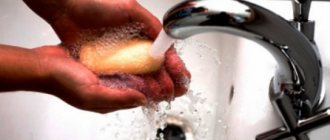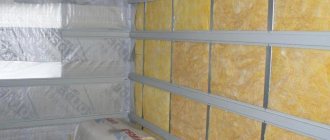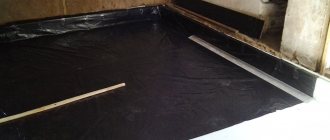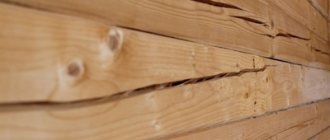The formation of soot and plaque on the walls in a Russian bath occurs as a result of a fire hazard or improper operation of heating equipment.
The smallest particles of soot can not only settle on wooden surfaces, but also penetrate deep inside. For this reason, it is important to promptly get rid of unpleasant plaque on walls and other surfaces.
How to quickly and effectively wash off soot in a bath without harming the wood?
Main recommendations
An important rule is to never use water or abrasive devices to clean wood walls. Immediately exclude such aids as:
- bleach or other chlorine-containing preparations;
- water;
- abrasive sponges;
- metal brushes;
- liquid soap;
- cleaning powders;
- sprayers;
- Karchers and steam cleaners.
Cleaning soot from the ceiling in a bathhouse Source alfaclean.by
Using a mechanical method to clean soot and deposits in a bathhouse Source remontnik.ru
When cleaning a bathhouse, be sure to follow safety rules and wear items of clothing that make contact with chemicals safe. These items include:
- working headdress (cap, headscarf, scarf);
- latex gloves;
- plastic buckets, basins (metal may oxidize);
- petal respirator (a four-layer gauze bandage is also suitable);
- robe;
- protective glasses.
When using special cleaning products for wood, be sure to read the instructions. Otherwise, you may harm the wood partitions.
Petal brush for cleaning wooden walls in a bathhouse Source ecosrub.ru
What to use?
Lining is a “breathing” building material, so it regularly absorbs dust, dirt, soot, and other types of contaminants from the air.
Coating its surface helps reduce damage to wood:
- impregnations;
- wax;
- paints (how to paint lining correctly?);
- varnish (how to varnish the lining?).
But even they will not completely protect the finishing board from stains appearing on it. What can and cannot be used to clean the lining?
Recommended means of removing contaminants from finishing materials include:
- soap solutions;
- scrapers with sharp bases;
- brushes for cleaning wood;
- grinding machines.
Before sanding the lining, you need to carry out a test stripping on a separate piece of material or on the least noticeable area of the surface being treated. Otherwise, instead of a clean slate, you may end up with completely damaged material.
What should not be used?
Do not clean the finishing board with:
- Hard metal brushes and sponges. Their aggressive impact will lead to an increase in wood porosity and even deeper penetration of contamination.
- Household chemicals (washing powder, dishwashing detergent, liquid soap). Such detergent compositions are not intended to work with lining, so the result of their impact on it is difficult to predict.
- Acidic, alkaline or chlorinated compounds for household use. For example, Belizna or Domestos are very helpful during cleaning, but they are completely unsuitable for disinfecting finishing building materials.
Firstly, all aggressive cleaning products have a strong, unpleasant odor that is absorbed into the wood literally forever. And, secondly, they reduce the protective functions of paints and varnishes, significantly reducing the service life of the lining.
Causes of soot and soot
Smoke with soot appears due to the low combustion temperature in the furnace or an improperly organized traction system. In such cases, when the boiler door is opened, clouds of smoke will come out and be absorbed by the walls. There are a number of other reasons why soot accumulates:
- The chimney pipe becomes overgrown with soot or a foreign object gets inside, making it difficult to remove the soot.
- Errors in the construction of heating equipment. Incorrect slopes, incorrect location of the smoke exhaust duct and the design of the stove itself can cause soot to appear. Only a thorough modification of the sauna heating will correct the situation.
- Strong wind. If the weather is bad outside, the wind can blow into the chimney. This will cause smoke to escape in the opposite direction. In this case, soot on the walls is inevitable. Some designs include a ridge, but often if the wind direction is unfavorable, it is absolutely useless.
- The appearance of cracks in brickwork. New holes begin to draw air out of the oven from all sides. This causes smoke to escape from the firebox. Even if you manage to ventilate the room, soot will still fall on the surface of the wooden walls.
- Smoke. If, after a long break, the firebox is not preheated, then smoke penetration into the room is inevitable. To prevent this, before starting the kindling, throw a few newspapers or a rag doused with gasoline inside, then set it on fire.
Single-story baths are a common practice; accordingly, the smoke exhaust system will be located lower. Therefore, bad weather and other factors that prevent normal air circulation inside the stove will cause smoke inside the room.
Cleaning walls in a bathhouse with ammonia diluted with water Source dizainvfoto.ru
Useful tips
The ceiling is decorated with chandeliers and all kinds of spotlights. And, of course, even the cleanest ceiling will not sparkle in a new way if there are dusty lighting fixtures on it. It happens that a bulky crystal or glass chandelier with many elements is difficult to remove from the ceiling. Then, using a stable table or stepladder, wash it directly on the ceiling. First, do not forget to unscrew the light bulb and insert paper into the socket.
As for spotlights, it is better to disassemble them for complete cleaning. The room must be de-energized and the lamps carefully removed. If you are afraid that you won’t be able to put everything back in place later, take a photo of the sequence in which you disassembled the structure. You can try to clean the lights without removing them. But then it will not be possible to fully clean the dirt from the inside that has accumulated between the ceiling and the lamp. In addition, there is a risk of damage to the tension surface. You may accidentally press down and enlarge the cuts made for the flashlights. There is also a risk of breaking the connection of electrical wires.
How often to wash the ceiling is up to you. It all depends on how many times a year you do general cleaning in the apartment, whether you wash the floors every day and wipe off the dust. After all, its particles settle on the ceiling, and over time turn into dirt under the influence of various factors. Where the ceiling is located also plays an important role.
A suspended ceiling located in the kitchen loses its original appearance faster than its “brothers” installed in the rooms. No matter how neat the owner is, the hanging structure will get dirty someday, and it will be “decorated” with grease and soot. Tension fabrics here need to be washed much more often than in other rooms, at least twice a year. And if the family is large and the cook is constantly steaming, frying, boiling and baking something, then general cleaning is required even more often. Otherwise, it will be very difficult to clean the ceiling well later.
Other rooms also have their own characteristics:
- In the bathroom, the ceiling suffers from limescale deposits, which in turn form steam and drops. In a large family, it will be useful to install a horizontal curtain; it will protect the upper part of the room from premature plaque.
- The suspended ceiling on the loggia needs to be wiped weekly with a dry towel. Here the coating will constantly gather dust, especially if there is a road nearby.
- In the living room you can afford to install a glossy multi-level ceiling with all kinds of lamps. This structure can be cleaned once a year during global cleaning.
- Fabric and matte canvases are typical for offices and bedrooms. Materials containing an antiseptic layer can simply be wiped with gauze.
- The same applies to hallways. But children’s rooms will most likely need wet cleaning as they become dirty; most likely this will happen more than once a year, or even twice, but much more often.
For more useful tips on how to wash a suspended ceiling, watch the following video.
Cleaning methods
Soot is very difficult to remove from wooden surfaces. For this purpose, two methods are used: mechanical and chemical.
Mechanical
All you need to do is dry the bathhouse thoroughly, ventilate it and make sure the walls are completely dry. All you have to do is be patient and use a stiff brush (not a broom, but the one you use to clean carpets, for example). Put on personal protective equipment and start cleaning.
Treatment of wooden surfaces in the bath after cleaning Source pk777.ru
Removing clogs through a fireplace
Mechanical cleaning of the chimney from the roof can be problem-free only if the channel runs straight. If the pipe has an angle, a turn, or an elbow, then you will have to do cleaning work from the side of the stove, because the tool will get stuck in the passage, and there will be no way to thoroughly and completely clean the hole.
Since it is much more difficult to remove soot from below due to the fact that gravity resists penetration, there are additional devices for cleaning from below - elastic rods with a handle, a flexible rope of large diameter with meter markings, stackable rods that are put on each other to adjust the length.
Preparatory work before cleaning
Regardless of which method you want to use to remove soot from a bathhouse, you must first prepare.
- Clear the room of unnecessary items (towels, soap, various hygiene products).
- Wear protective clothing: be sure to wear gloves, a respirator, and goggles (choose special plastic ones with good transparency).
- Cover clean surfaces with polyethylene or any film to prevent dust and dirt from getting into these places.
- Take a broom and a hard-bristled brush and clean the top layer of dirt. Also remove all cobwebs and small debris from the coverings.
- After completing the steps, you can proceed to the main type of processing: mechanical or chemical method.
Elastic melamine sponge for removing soot from wooden walls in a bathhouse Source khoz-byt.rf
We suggest studying the list of expected materials and tools that will be required for the mechanical removal method:
- a long-handled brush-brush is suitable for removing dirt from crevices and corners;
- a sharp knife or knitting needles will help remove soot in hard-to-reach places: between logs, behind the stove;
- sandpaper with a fine degree of abrasiveness (it will help to carefully remove too fine dry soot without damaging the wood);
- A melamine sponge is suitable if there are small and non-permanent stains on the walls. This device acts like an eraser.
Please note that you can use folk remedies to clean soot from wooden walls. For example, crushed red brick. Its crumbs are rubbed onto walls in areas of contamination. This promotes removal. The spray can be applied to a dry cloth or sponge.
Brick chips for cleaning walls from soot in a bathhouse Source tennisitpro.rf
Grinding
If the lining has darkened slightly, how can you lighten it by sanding? In the case where the blackening has not penetrated to a great depth, you need to take an angle grinder with a power of up to a kilowatt for a wheel with a diameter of 125 mm. For doing the work yourself, this is the safest and easiest to use option. You can remove the protective cover from the machine. This is a safety precaution, but it allows you to get into all the grooves of the wood panels to thoroughly clean them.
Craftsmen recommend using a flap grinding wheel. This is a special device with ribs over the entire surface. The optimal grain size is about 40 units (on sale you can find wheels from 36 to 150). The lower this value, the rougher the processing will be. To completely eliminate blackness, it is usually necessary to remove the top layer of wood 3 or more millimeters thick.
Household chemicals
In order not to complicate the work of cleaning the bathhouse, you can stock up on special products for removing soot and soot:
- BZ-20. A good lye based cleaner. Suitable not only for removing dry soot, but also smoky, greasy marks. Thus, except in the bath, the product can be used to remove greasy deposits in the kitchen.
- Pure Deso. This solution is usually used for final cleaning. That is, after removing the bulk of the contaminants. It is compatible with any composition and does not damage the wood surface.
- Facade cleaner No. 2. An interesting multifunctional solution that helps remove soot and neutralize harmful substances. It has a disinfecting effect on walls and helps get rid of fungus and mold.
- Mazbit+. Specially designed for removing traces of fire and smoke from wooden surfaces. It acts gently, does not damage the structure of the walls, its consistency remains imperceptibly on the coating and prevents the penetration of contaminants into small pores and crevices.
It is advisable to use these chemicals one at a time. Because mixing of odors may occur. This is very dangerous for your respiratory system. If you accidentally inhale the vapors, acute poisoning is possible.
Disinfecting walls in a bathhouse after cleaning from soot Source banyabest.ru
On a note! Before using any chemical composition, be sure to read the instructions for use.
Why does the chimney become dirty?
How to clean a chimney in a bathhouse depends on the nature of the contamination. With use, types of clogging may occur such as:
- soot and soot, which accumulates very quickly when burning household waste;
- condensation that forms due to irregular use of the bathhouse;
- foreign objects accidentally falling into the chimney.
All of these types of contaminants ultimately impede the free circulation of air and the escape of smoke through the chimney.
This may cause carbon monoxide poisoning. Condensate is a weakly concentrated acid solution. Under its influence, the chimney masonry begins to collapse from resinous deposits. If you use a sauna regularly, you need to make a schedule and determine in advance when and how to clean the pipe in the sauna. Carrying out such work regularly will preserve the chimney and stove and allow you to use the sauna without any problems.
Application of vinegar essence
It is necessary to dilute the product with water in a ratio of 1: 2, then thoroughly mix the two components, then apply the prepared product to the soft side of the sponge. Afterwards, all that remains is to wipe the contaminated surfaces with the composition until streaks appear, then rinse the sponge and reapply the diluted essence. This should be done until the soot completely disappears from the surface. Then you need to wipe it with a damp cloth.
On a note! If the soot layer is thick enough, then the vinegar is not diluted, but used in its pure form.
Complete cleaning of the apartment
For cleaning to be successful, the apartment must be cleaned step by step and correctly.
You need to start with dry cleaning of distant rooms and finish it in the bathroom and toilet. Most of the soot accumulates at the top as smoke and fine particles rise upward.
Open all the windows in your house or apartment. This must be done so that the smell of smoke disappears. If there was a fire, all damaged items must be taken outside. Remove visible debris. Curtains and carpets are removed and taken outside. They will need to be shaken well and washed. Alternatively, you can also take it to the dry cleaner.
After cleaning up the trash, start cleaning the ceiling and walls. If there is burnt wallpaper on the walls, remove it with a staple. Wash windows, window sills, windows and doors thoroughly.
If there was a fire in the room, it is better that all surfaces remain clean after it, otherwise, after repairs, a burning smell may persist.
Now take a broom and walk it over the entire surface of the house. This way you can collect small soot particles. Next, use a vacuum cleaner. Walk it over all surfaces to collect the smallest particles of dirt. Finally, carry out wet cleaning, adding detergent to the water.
Change the water more often to prevent soot residue from settling back on the surface. It is best to throw dirty water outside if possible. The main thing is not to rush during the work process, otherwise if you miss something, you will need to start all over again.
Final disinfection
Humidity, which is constantly present in bath rooms, leads to the development of mold or mildew. Therefore, even after cleaning the surface from soot, carbon deposits and soot, it is necessary to carry out disinfection. Antiseptics diluted in water are suitable for this: Domestos gel, ethyl alcohol, potassium permanganate, a solution of salt and copper sulfate dissolved in water in a ratio of 18 g, 44 g per 1 liter of water, respectively.
Then, after cleaning and disinfection, you can apply preventative agents to the surface that will repel dirt and prevent it from eating deep into the wood structure. This manipulation allows you to maintain the appearance and neatness of the steam room.
Important! Never use soapy water or sponges. By wiping the surface, all the particles will penetrate into the wood, making it impossible to remove dirt. The only option in this case is to remove the layer of wood along with the contamination. But this is not a reliable practice, since after this the soot will accumulate even more actively.
Features of washing various surfaces
In one house there are coverings made of different materials. Therefore, you need to know how soot is washed off from each of them, and in what ways.
Laminate and plastic
You can remove soot from the floor and furniture using solvents. They easily clean laminate flooring from soot. And plastic coverings are wiped with a rag soaked in kerosene. Industrial alcohol also cleans well.
Glass
Glasses are cleaned with crumpled paper. Then it should be washed with window cleaning liquids. It is necessary to carry out the operation several times, changing rags.
Wood and metal
Soot eats into wooden coverings strongly. You will have to remove the top layers with sandpaper or a sander. Both river sand and brick chips will do. But polished and varnished surfaces cannot be cleaned in this way.
Water-based paint
Ceilings and walls are cleaned with a solution of industrial alcohol. If the soot is covered in a thick layer, it is better to remove the top layer of paint. Whitewashing with lime can be washed off with warm water and the walls can be renewed again.
Brick
The bricks are washed from burning using a soap solution. If the layer of soot is strong, then wipe with vinegar after pre-moistening with water. Then brush over the brickwork.
Prevention of soot and soot in the steam room
The most important condition for maintaining cleanliness in the bathhouse is maintaining the proper operation of the traction system. To do this, the following list of measures is taken:
- sealing cracks in a brick kiln immediately after they appear.
- internal cleaning of chimneys from layers of soot.
- firebox with chimney-sweep logs: aspen firewood, potato peelings.
- Regular removal of ash from the ash pit.
- cleaning all surfaces in a bath with soda solution several times a year.
Precautions when cleaning an apartment after a fire
To remove traces from different surfaces, you need to follow the rules. Cleaning principles that prevent health hazards:
- Well ventilated area. While cleaning the walls and ceiling from soot, many soot particles float in the air after a fire. Manipulation helps to avoid diseases of the lungs and respiratory tract.
- Correctly selected clothes. The whole body must be covered.
- Increased air humidity.
- Protective mask, goggles, gloves.
To wash off the soot formed after a fire, it is necessary to use chemicals and improvised means. To remove traces, you can use the services of a cleaning service.
The article has been verified by the editors
Brick
How to remove soot from a brick stove in a bathhouse? One of the most effective methods is to use a simple detergent and sponge. You need to take the detergent, dilute it with water and whisk until a thick foam forms. The treated surface should be left for 10-15 minutes, then rinsed with water.
Another great way is to use vinegar essence. You will need tap water and table vinegar. For one glass of vinegar you need to take two glasses of water. Don't forget to use gloves! Apply the solution to the brick, leave for 10 minutes, then rinse thoroughly. How to wash off soot if it has penetrated deep enough into the brick pores?
Tags: bathhouse, wood, soot, wash off
« Previous entry
Metal
Cleaning metal structures is a fairly simple procedure: you will need a clean, damp sponge and soap solution. If the soot layer is too dense, you can use fine river sand. True, it must be borne in mind that abrasive materials perfectly clean metal, but at the same time they contribute to the appearance of corrosion and can destroy it.
For this reason, experts recommend using abrasives only if no other cleaning method is suitable. After this, it is necessary to paint all damaged surfaces. Neutral chemical compounds and removers are much better suited, because they will not only clean the metal surface, but also will not damage it. Among the folk methods, one can note the purification of metal using water in which citric acid is diluted, or Coca-Cola.
Protective varnishes for lining processing
When deciding on the best way to impregnate the lining in a bathhouse, it is important to take into account that ordinary paint and varnish compositions cannot be used for these purposes. Paint and varnish reduce the breathability of wood, which can lead to the accumulation of excess moisture in the fibers and further rotting.
The optimal choice is water-based moisture-proof varnishes with high thermal insulation characteristics, used to create a durable polymer coating.
Varnish compositions are of the following types:
- Acrylic. Universal products designed for treating bath surfaces. They protect wood from contamination, are easy to apply and dry quickly. The only drawback of the compositions is the appearance of an unpleasant odor when heated, so they can be used for the dressing room and rest room.
- Alkyd. Provide reliable protection from high humidity and hot steam. Disadvantages include: long drying time, unpleasant odor.
- Water-based. Environmentally friendly and safe compositions, dry quickly and do not emit a strong odor when heated. It is allowed to process the lining in a bath in the washing and steam departments.
- Polyurethane. Used for internal and external protection of bath surfaces from color fading. They can be completely transparent or colored.
- Acrylic-polyurethane. The formulations are designed to combat mold and pathogenic microorganisms. In addition, they give the wood an attractive shine and polishing effect.
How to cover wooden lining in various functional areas of the bathhouse? For this you can use the following compositions:
- “Eurotex Sauna” is an acrylic-based varnish that contains wax and an antiseptic. It reliably protects the wooden surface from high temperatures. In addition, the varnish prevents the accumulation of moisture, the formation of mold and the development of microorganisms. The product is absolutely safe and has a neutral odor.
- Interier Sauna is a colorless antiseptic acrylic composition designed to protect wooden surfaces. Not used for ceilings.
- “Pirilax” is a complex of antiseptic preparations used in old and new baths to protect the lining from contamination, fire and corrosion. The compositions are ideal for rooms with special operating conditions - steam rooms, dressing rooms and washing rooms.
